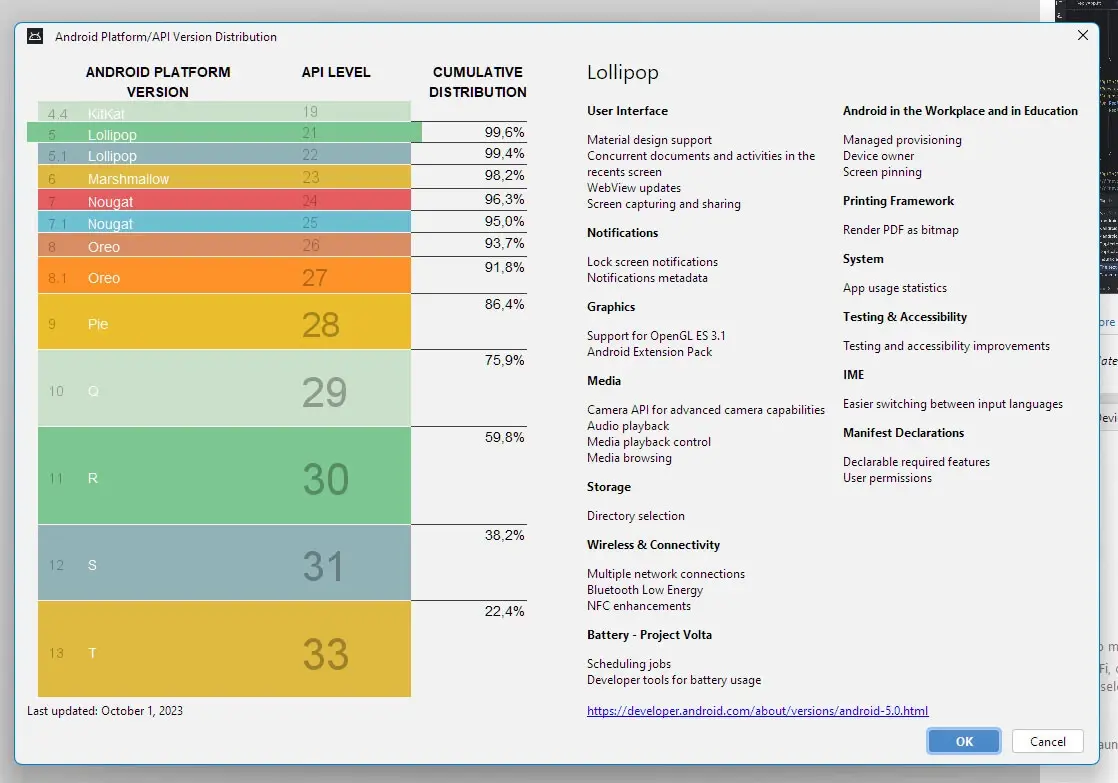Highlights
- Android 13 emerges as most widely used, operating on 22.4% of Android devices.
- Older Android 11 and Android 10 versions still hold substantial market shares.
- Android 9 continues to linger despite reaching end-of-life status.
- Android 14 is yet to make its mark in the distribution statistics.
In a positive turn of events for Google’s Android platform, the latest version, Android 13, has risen to prominence as the most widely used OS variant, according to updated distribution statistics.
Data revealed in Android Studio, as reported by GizChina and Mishaal Rahman, shows that as of October 1, 2023, Android 13 is operating on 22.4 percent of Android devices.
This signifies a significant uptick of 7.4 percent in just four months since the previous update in May 2023, indicating an impressive adoption rate for an OS that has only been out for a little over a year.
However, while Android 13 takes the lead, it’s worth noting that Android 11 still commands a noteworthy share, holding onto 21.6 percent, albeit down from 23.1 percent in May.
It seems rather telling that a version released back in 2020 remains so prevalent among users.
Furthermore, Android 10 is not far behind, securing its place as the third most popular version, despite experiencing a 1.7 percent decline.
It currently runs on 16.1 percent of all devices.

Amid these numbers, there is cause for concern.
Android 12 saw a marginal decrease from 16.3% to 15.8%, ranking it as the fourth most popular OS version.
Even more alarming is the presence of Android 9 in the distribution charts, accounting for 10.5 percent of Android devices.
Given that these devices have hit their end-of-life stage, they are unlikely to receive any further updates.
This trend highlights the lingering issue of fragmentation that Android faces.
With Android 14 having just been launched at the beginning of October, its absence from the distribution chart is understandable, as Google collected the data just days before its stable build was released.
However, only a handful of devices from Samsung and Xiaomi have so far been updated to this new version.
The Android ecosystem appears to be moving in a positive direction, with manufacturers promising longer software support to reduce fragmentation.
Yet, the real challenge lies in the speed of OS rollouts, which needs to improve substantially for the landscape to become more unified.
FAQs
What is the current most popular version of Android?
Android 13 is the most popular version according to the latest data from Android Studio, accounting for 22.4% of the market share.
Are older Android versions still prevalent?
Yes, Android 11 and Android 10 still maintain significant market shares, with 21.6% and 16.1% respectively, highlighting the fragmentation issue in the Android ecosystem.
Why is Android 9 still showing up in the distribution charts?
Android 9 accounts for 10.5% of the Android market. These devices have reached end-of-life and are not expected to receive further updates, which is a concern for the Android ecosystem.
Is Android 14 included in the latest distribution data?
No, Android 14 was not included since the stable build was released after the data collection period. However, only select Samsung and Xiaomi phones have received this update so far.
Also Read: Xiaomi to launch Android 13-based MIUI 14 with India-exclusive features to release on February 27th
Also Read: Xiaomi Smartphones’ Battery Customization Via MIUI
